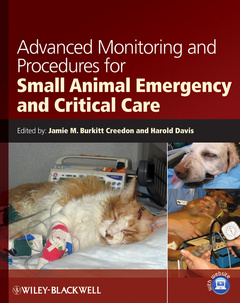Description
Advanced monitoring and procedures for small animal emergency and critical care (paperback)
Authors: CREEDON Jamie M. Burkitt, DAVIS Harold
Language: English
Approximative price 110.91 €
In Print (Delivery period: 12 days).
Add to cart944 p. · Paperback
Description
/li>Contents
/li>
Organized primarily by body system, each chapter covers general principles, indications, equipment, techniques, basic interpretation, troubleshooting, and contraindications. Standardized protocols supply equipment lists and step-by-step instructions throughout, and a companion website offers images from the book in PowerPoint and protocols as downloadable Word files. Advanced Monitoring and Procedures for Small Animal Emergency and Critical Care is a valuable resource for any veterinary staff member with an interest in improving the standard of care in emergency and critical care medicine.
Key features
- Comprehensive, practical reference for advanced technical procedures in emergency and critical care
- Organized by body system and general topics with an easy-to-use format
- Provides reliable, hands-on information for the proper performance ofmonitoring and emergency caretechniques
- Offers well-referenced recommendations to improve the standard of care
- Written by an expert international team of veterinarians and veterinary technicians
- Includes access to a companion website with images from the book and the protocols at [URL]
2. Introduction to Intensive Care.
Section I: Cardiovascular.
3. Catheterization of the Venous Compartment.
4. Arterial Puncture and Catheter Placement.
5. Electrocardiography.
6. Basic Electrocardiogram Interpretation.
7. Principles of Arterial Blood Pressure Monitoring.
8. Indirect Arterial Blood Pressure Monitoring.
9. Direct Arterial Blood Pressure Monitoring.
10. Central Venous Pressure Monitoring.
11. Use of the Pulmonary Arterial Catheter.
12. Bedside Echocardiography.
13. Other Cardiac Output Monitoring Techniques.
14. Monitoring Tissue Perfusion: Clinicopathologic Aids and Advanced Techniques.
15. CPR Techniques.
16. Defibrillation.
17. Temporary Pacemakers.
18. Emergency Thoracotomy.
19. Pericardiocentesis.
Section II: Respiratory.
20. Oxygen Therapy.
21. Arterial Blood Gas Interpretation.
22. Pulse Oximetry and Co-oximetry.
23. Rapid Sequence Intubation.
24. Tracheostomy Tube Placement.
25. Artificial Airway Management.
26. End-Tidal CO2 monitoring.
27. Mechanical Ventilation.
28. Basic ventilator waveform analysis.
29. Pleural Space Drainage.
30. Thoracic Imaging in the Critically Ill Patient.
Section III: Renal.
31. Urinary Catheter Placement.
32. Urine Evaluation.
33. Peritoneal Dialysis.
34. Hemodialysis.
Section IV: The Abdomen.
35. Peritoneal Evaluation.
36. Gastrointestinal Decompression and Decontamination.
37. Management of the Open Abdomen.
Section V: Nutrition.
38. Nutritional Requirements in Critical Illness.
39. Assisted Enteral Feeding.
40. Parenteral nutrition.
41. Enteral Diets.
Section VI: Analgesia and Anesthesia.
42. Pain Control.
43. Drug Administration.
44. Systemic Analgesia - basic overview of these classes with patient considerations included.
45. Local Analgesia.
46. Monitoring the Anesthetized Patient.
47. Nursing Care of the Long-Term Anesthetized Patient.
Section VII: Clinicopathologic Techniques.
48. Blood Sample Collection and Handling.
49. In-house Hematological Evaluation.
50. Serum Electrolyte Evaluation.
51. Osmolality and Colloid Osmotic Pressure Measurements.
52. Cytology.
53. Blood Banking.
54. Blood Typing and Cross-Matching.
55. Transfusion Monitoring.
Section VIII: ("Other"?) Monitoring Techniques.
56. Continuous Blood Glucose Monitoring.
57. Intracranial Pressure Monitoring.
Section IX: Special Nursing Considerations.
58. Care of Indwelling Device Insertion Sites.
59. Care of the Brain Injured Patient.
60. Care of the Immobile Patient (?).
61. Specialized Care.
62. Aseptic Technique.
63. Minimizing Nosocomial Infection.
64. Handling Radioactive and Other Biohazardous Waste.
65. Medical Charting.
66. Compassion Fatigue




